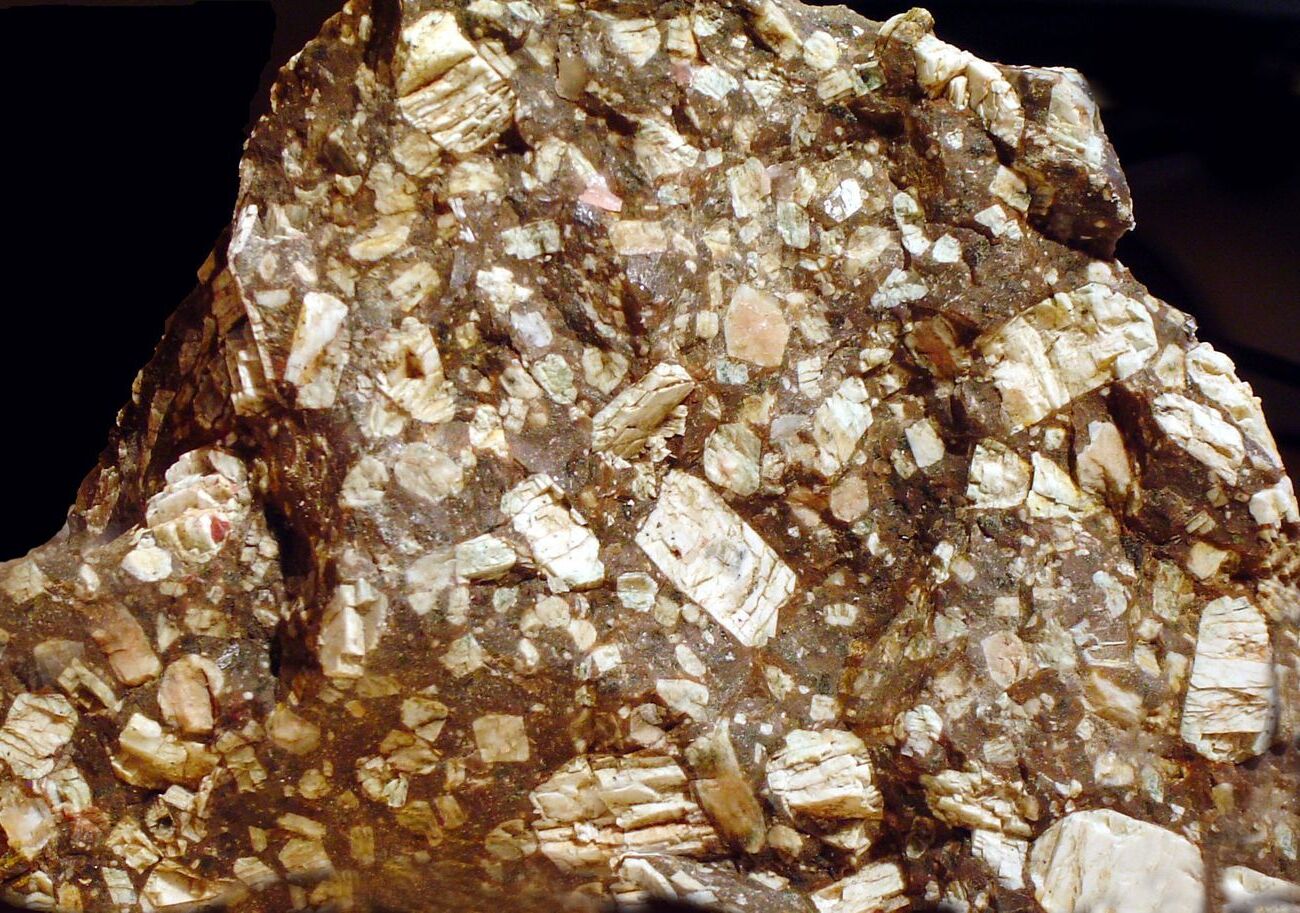
What is andesine? Andesine is a fascinating mineral that belongs to the plagioclase feldspar family. Known for its variety of colors, including white, gray, green, yellow, and flesh-red, andesine is often found in intermediate igneous rocks like diorite, syenite, and andesite. This mineral crystallizes in the triclinic system and exhibits perfect cleavage, making it a favorite among gemologists. However, andesine's market presence has been marred by controversy, particularly regarding artificially colored red and green gemstones. These treated stones have sparked debates and led to rigorous testing to ensure authenticity. Let's delve into 45 intriguing facts about andesine, from its chemical composition to its gemological properties and the controversies that surround it.
Key Takeaways:
- Andesine is a colorful mineral with unique properties, found in igneous and metamorphic rocks. Its gemstone use and controversies make it a fascinating subject for research and investigation.
- Gemologists study andesine's physical and optical properties, while addressing controversies around artificial coloration. Research and field investigations provide valuable insights into this captivating mineral.
What is Andesine?
Andesine is a fascinating mineral that belongs to the plagioclase feldspar group. It’s known for its variety of colors and unique properties, making it a significant player in gemology. Let's dive into some intriguing facts about andesine.
-
Chemical Composition: Andesine's chemical formula is (Ca, Na)(Al, Si)4O8, with a calcium to sodium ratio between 30 and 50%.
-
Crystal System: This mineral crystallizes in the triclinic crystal system, featuring unique lattice parameters.
-
Crystal Class: Andesine falls under the pinacoidal (1) crystal class.
-
Space Group: It belongs to the space group P1.
Where Can You Find Andesine?
Andesine is found in various geological settings, often in association with other minerals. Here are some details about its occurrence and associated minerals.
-
Occurrence: Commonly found in intermediate igneous rocks like diorite, syenite, and andesite. It also appears in metamorphic rocks and sedimentary rocks as detrital grains.
-
Associated Minerals: Often found alongside quartz, potassium feldspar, biotite, hornblende, and magnetite.
Physical Characteristics of Andesine
Understanding andesine's physical properties helps in identifying and appreciating this mineral. Here are some key characteristics.
-
Color: Andesine can be white, gray, green, yellow, or flesh-red.
-
Crystal Habit: Typically rare, with crystals usually not exceeding 2 cm. It often appears in massive or granular forms.
-
Twinning: Commonly exhibits twinning following albite, pericline, and carlsbad twin laws.
-
Cleavage: Has perfect cleavage on the {001} plane and good cleavage on the {010} plane.
-
Fracture: The fracture is uneven to conchoidal.
-
Tenacity: Andesine is brittle.
-
Mohs Scale Hardness: Ranges from 6 to 6.5.
-
Luster: Exhibits a subvitreous to pearly luster.
-
Streak: The streak is white.
-
Diaphaneity: Can be transparent to translucent.
-
Specific Gravity: Ranges from 2.66 to 2.68.
Optical Properties of Andesine
The optical properties of andesine are crucial for gemologists. These properties help in identifying andesine and distinguishing it from other minerals.
-
Optical Properties: Andesine is biaxial (+/−), with refractive indices ranging from nα = 1.543 to 1.554, nβ = 1.547 to 1.559, and nγ = 1.552 to 1.562.
-
Birefringence: The birefringence is δ = 0.009.
-
2V Angle: Measured between 76° and 83°.
-
Diagnostic Features: Accurate identification requires detailed optical study, chemical analysis, or density measurements.
History and Naming of Andesine
The history and naming of andesine provide context to its discovery and significance.
- Name and Discovery: First described in 1841 at the Marmato mine in Colombia. Named after the Andes mountains due to its abundance in andesite lavas.
Andesine as a Gemstone
Andesine's attractive colors and transparency make it a popular choice for gemstones. However, its market presence has been controversial.
-
Gemstone Use: Sometimes used as a gemstone due to its appealing colors and transparency.
-
Red and Green Controversy: In the early 2000s, red and green gemstones marketed as 'andesine' were found to be artificially colored, sparking controversy.
Mining Locations and Production
Andesine is mined in various locations, with significant production coming from Tibet and Inner Mongolia.
-
Tibetan Andesine: Mined near Xigazê, Tibet, from an alluvial secondary deposit.
-
Inner Mongolian Andesine: Mined from secondary alluvial deposits in Shuiquan and Haibouzi villages.
-
Mining Locations: Includes regions around Xigazê in Tibet and Shuiquan and Haibouzi in Inner Mongolia.
-
Annual Production: Up to 100 tons produced annually from Inner Mongolian mines.
Crystal Morphology and Color Variations
The morphology and color variations of andesine crystals are essential for gemologists and collectors.
-
Crystal Morphology: High transparency, somewhat rounded crystals, typically 0.3 to 5.5 cm in diameter.
-
Color Variations: Most are pale yellow, with colorless or deep yellow stones being rare.
Gemological Studies and Controversies
Extensive studies have been conducted to understand andesine's properties and address controversies.
-
Gemological Study: Detailed study by Ahmadjan Abduriyim, including EPMA chemical analyses and XRD measurements.
-
Optical Characterization: RI measurement correlated with andesine, showing specific refractive indices.
-
EPMA Chemical Analysis: Calculated an empirical chemical formula correlating to andesine or andesine-labradorite.
-
XRD Measurements: Lattice parameters calculated from XRD measurements.
-
Gemological Properties: High transparency, rounded crystal morphologies, and specific gravity ranging from 2.66 to 2.68.
Artificial Coloration and Market Misrepresentation
The artificial coloration of andesine has led to significant market misrepresentation and controversy.
-
Artificial Coloration: Red and green colors induced through diffusion treatments.
-
Controversy Over Red and Green Colors: Documented through Raman scans and microphotographs, showing these colors are not naturally occurring.
-
Market Misrepresentation: Dealers accused of selling treated stones as natural, leading to consumer fraud.
Research and Field Investigations
Research and field investigations have been conducted to verify the authenticity of andesine and understand its properties.
-
Gemological Study of Treated Feldspar: Study by GIA highlighted challenges in distinguishing between natural and artificially colored stones.
-
Research on Gem Feldspar: Conducted by Ahmadjan Abduriyim and team, focusing on andesine from the Shigatse region of Tibet.
-
Geological Field Investigation: Conducted by Wang et al. to verify the natural occurrence of red andesine in Tibet.
-
Effects of Heating and Copper Diffusion: Ongoing research on how heating and copper diffusion affect feldspar.
Publications and Research Contributions
Various publications and research contributions have provided valuable insights into andesine.
-
Gem News International: Published articles on andesine, including reports on visits to mines in Tibet and Inner Mongolia.
-
Journal of Gemmology: Published articles on andesine's properties and market presence.
-
GIA Research: Extensive research on andesine's chemical composition, optical properties, and effects of heat treatment.
The Fascinating World of Andesine
Andesine is a captivating mineral with a rich history and diverse properties. Found in intermediate igneous rocks like diorite and andesite, it boasts a range of colors from white to flesh-red. Its perfect cleavage, subvitreous luster, and transparency make it a sought-after gemstone. However, the market has seen controversies, especially with artificially colored red and green stones. Mining locations in Tibet and Inner Mongolia have been pivotal, producing up to 100 tons annually. Detailed studies, including those by the GIA, have shed light on its chemical composition and optical properties. Despite the controversies, andesine remains a significant mineral in gemology. Its unique characteristics and the ongoing research ensure it continues to intrigue both scientists and gem enthusiasts alike. Whether natural or treated, andesine's allure is undeniable, making it a gem worth exploring.
Frequently Asked Questions
Was this page helpful?
Our commitment to delivering trustworthy and engaging content is at the heart of what we do. Each fact on our site is contributed by real users like you, bringing a wealth of diverse insights and information. To ensure the highest standards of accuracy and reliability, our dedicated editors meticulously review each submission. This process guarantees that the facts we share are not only fascinating but also credible. Trust in our commitment to quality and authenticity as you explore and learn with us.


